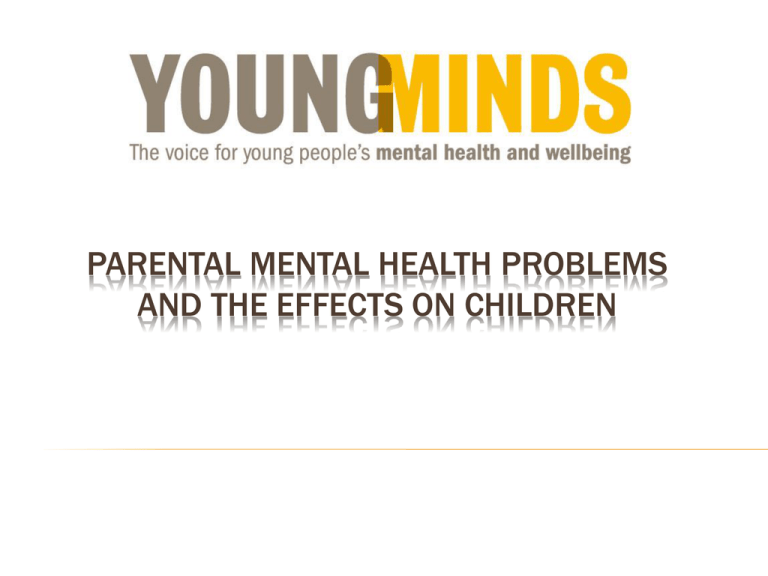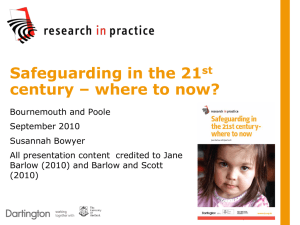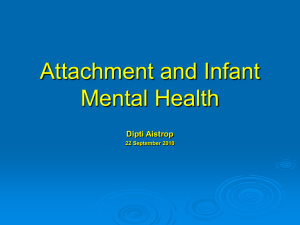Presentation: Parental Mental Illness
advertisement

PARENTAL MENTAL HEALTH PROBLEMS AND THE EFFECTS ON CHILDREN AIMS You will be able to: • Briefly describe the main adult mental health problems and the pathways through which problems may be transmitted within parent child relationships • Identify specific risk factors relating to children with a parent with a mental health problem • Describe adaptive strategies and resultant behaviours in children • Practice talking with children about mental illness/substance misuse • Consider the implications of the above for your practice DEFINITIONS AND CLASSIFICATION MENTAL DISORDER OR HEALTH PROBLEM? • • “…the existence of a clinically recognisable set of symptoms or behaviour associated in most cases with distress and interference with personal function.” WHO Mental health problems are more transient, less definable and common, but will impact on personal functioning ICD 10 • Mood Disorders • • • • • Mania Bipolar affective disorder Depression Schizophrenia Organic Disorders • • Alzheimers Dementia associated with other diseases ICD 10 • • Substance Misuse Disorders Behavioural Syndromes • • • Developmental disorders • • Eating disorders Sexual dysfunction ASD Behavioural/emotional disorders • • • ADHD Conduct Disorder Tics ICD 10 • Neuroses • • • • Disorders of adult personality • • Phobias Obsessive compulsive disorders PTSD Personality disorders Learning disabilities DEPRESSION • • Reactive depression Endogenous depression • Four areas affected • • • • Mood – misery Cognition-reduce concentration/self esteem Physical – poor sleep, diurnal variation & poor appetite Accumulative interactive impact – guilt, helplessness, lack of future, ideas about death/suicide DEPRESSION • Key symptoms: Misery Diurnal variation Poor appetite Lowered self esteem • • Severe depression include the above plus 3 or 4 of the others Severe depression with psychosis – all ten symptoms plus delusional states MANIA • • • • • Mood – positive to ecstatic Cognition – speeding of thoughts and speech Physical symptoms – never tires, agitated Accumulative interactive impact – ecstatic expansion of self Can be associated with psychotic symptoms BIPOLAR DISORDER • Repeated phases of mania followed by depression usually with recovery in between SCHIZOPHRENIAS • Disordered thoughts • • • Perception and affect disturbed • • Not in control, stuporised Disorder of senses • • Incongruity of mood Disorder of volition • • Speeded up thoughts or thoughts blocked Intrusive or broadcasted thoughts Hallucinations Primary delusions • • False beliefs (time and culturally influenced) Can be paranoid PERSONALITY DISORDERS • • • • Paranoid – other people are interpreted as demeaning or threatening Schizoid – indifference to social relationships/ restricted range of emotional experience and expression Anti Social – callous unconcern for others or social norms Emotionally unstable – impulsive with affective instability RISK Biological Genetic loading In-utero exposure to toxins Stress RISK Psychological Insecure attachments Learned negative cognitive distortions Parentification Negative attributions Chronic trauma Social Poverty Stigma Reduced educational role Impaired social interactions -poor self esteem -parents not promoting social adaptations TRANSMISSION PATHWAYS • What gives rise to the risk of parental mental health problems also create risks to the parentchild relationship • E.g. Long standing attachment problems likely to lead to increased risk of adult depression and impact on the effectiveness of parenting TRANSMISSION PATHWAYS • • What gives rise to the risk of parental mental health problems also create risks to the parentchild relationship PLUS The parental mental health problem also increases risk • Insensitive parenting arising from risks to the parental mental health problems is further worsened by the mental health problem TRANSMISSION PATHWAYS • Mental health problem alone • E.g. Lack of affect is disturbing to a child. PARENTING AND THE IMPACT ON PARENTING BEING A PARENT DEPENDS ON ... • • • • • • • • • • Our personality and temperament Whether we have the support of a partner Whether we have the support of family and friends How many children we have and what ages and developmental stages they are at Whether our children are physically and mentally healthy or whether they are coping with significant health or developmental problems Whether we are combining child care with the demands of paid employment Whether we have enough money to bring up our family or are finding it hard to make ends meet Whether we live in comfortable housing or are struggling with poor accommodation Whether we are coping with stressful events in our lives such as a separation, a bereavement or unemployment The experiences we had in our own childhood, and whether or not we have been able to come to terms with any problems that we faced when we were young Youngminds (2004) Looking After Ourselves NEGATIVE EMOTIONS GENERATED THROUGH BEING A PARENT • • • • • • • • • Anger Resentment Exhaustion Envy Boredom Guilt Sadness Disappointment Despair Youngminds (2004) Looking After Ourselves PROBLEMS IN PARENTING • • • • • • • • • Physical exhaustion Feeling tearful Feeling depressed Feeling agitated Feeling angry more often than is usual for you Difficulty sleeping Mood swings Feelings of panic Difficulty concentrating Youngminds (2004) Looking After Ourselves • • • • • • • Difficulty making decisions Losing interest in life Avoiding other people Negative thoughts Suicidal thoughts Not eating or over-eating Smoking or drinking more than is usual for you IMPACT ON PARENTING • • Parental mental health problems are highly correlated with poverty and deprivation, poor housing and social adversity. For some the stigma of mental health problems and racism further exacerbate risk to children IMPACT ON PARENTING • Attachment relationships • • Communication • • Combination of discord and mental health problems is very dangerous to children Separation and Change • • Children need information Adult Conflict • • Emotionally attuned engagement Children fear parental separation. Also fear being removed from the family and fear parents admission to hospital Peer Friendships and Support • Friendships change for the worse IMPACT ON PARENTING • Parental Behaviour • • Children’s behaviour • • Most parents with mental health problems do not pose a risk to children. For those that do they are more likely to have been psychotic, co-morbid and socially deprived. Some evidence that the severity of parental mental health problems increases likelihood of children’s behaviour problems Coping • Non productive coping styles/avoidance in parents are adopted by children IMPACT ON PARENTING Parents may • be unable to ensure the basic (physical) care and safety of children • readily attend to a child’s physical needs (such as maintaining a ‘spotless home environment’) but struggle with the provision of warmth and praise • not appreciate their child as an autonomous individual with his or her own separate, age-dependent needs • expect their child to behave as an adult and to undertake a variety of adult tasks and responsibilities (for example, role reversal with developmentally inappropriate expectations) IMPACT ON PARENTING Parents may • be unable to play with and provide adequate stimulation for their child • struggle to provide appropriate guidance, boundaries and necessary stability for their children • become frustrated when efforts to discipline their children are unsuccessful (escalating cycles of coercive exchange have been well described; criticism and hostile responses may occur and physical punishments ensue, which may in turn result in physical harm) • be unaware of the nature and extent of their children’s emotional needs. SPECIFIC RISK FACTORS • • • • Persistent negative views expressed about a child, including rejection Ongoing emotional unavailability, unresponsiveness and neglect, including lack of praise and encouragement, lack of comfort and love and lack of age appropriate stimulation An inability to recognise a child’s needs and to maintain appropriate parent child boundaries Ongoing use of a child to meet a parent’s own needs SPECIFIC RISK FACTORS • • • • • Distorted, confusing or misleading communications with a child including; involvement of the child in the parent’s symptoms or abnormal thinking, including, for example, delusions targeting the child incorporation of the child into a parent’s obsessional cleaning/contamination rituals, or keeping a child at home because of excessive parental anxiety or agoraphobia Ongoing hostility, irritability and criticism of the child Inconsistent and/or inappropriate expectations of the child. ATTACHMENT AND CHILD DEVELOPMENT ATTACHMENT THEORY • Attachment behaviour is defined as • • the seeking of protection when anxious which is triggered by external threats or behaviours. The person to whom a child is attached provides a secure base, a place of safety, warmth and comfort. ATTACHMENT THEORY A securely attached child feels confident that should they feel anxious, their parents will respond. Such security is brought on by interactions which are sensitivity regularly available and reliable warm responsive, and consistent WAY ATTACHMENT DEVELOPS need tru st re la xa tio n se cu rity a tta ch m e n t sa tisfy need a ro u sa l - re la xa tio n cycle h ig h a ro u sa l INSECURE AVOIDANT ATTACHMENTS Children who anxiously avoid contact have been rejected. This avoidant attachment behaviour is a way of coping with distress. The distress itself is turned inwards and the view of self which emerges is an unworthy one. Adults are experienced as unavailable, untrustworthy and rejecting. REPRESENTATIONAL MODEL (AVOIDANT) Caregiver subtly or overtly reject child’s attachment needs at time of stress Bids for comfort will be rebuffed Child keeps his/her attention directed away from their caregivers in an effort not to arouse anxiety and frustration In control because of the need for self reliance Comfort self rather than accept it from others REPRESENTATIONAL MODEL (AVOIDANT) • The infant cannot approach because of the parent’s rejection and cannot withdraw because of its own attachment needs. Rebuff heightens alarm and hence heightens attachment, leading to increased rebuff. By repelling the infant the mother simultaneously attracts him. INSECURE AMBIVALENT ATTACHMENTS Children who show an ambivalence in their attachments have experienced inconsistent or chaotic care. Their attachment behaviour is intensified to attract the parent. Relationship meets mother’s needs rather than those of the infant Such children are often angry and resent their carers. REPRESENTATIONAL MODEL (AMBIVALENT) Caregiver will be inadequate at meeting child attachment needs (caregiver is passive, unresponsive and ineffective) Child’s strategy is to amplify attachment needs and signals in an effort to arouse a response (verbal and behavioural: bubbly affection to rage, anger, panic and despair. All experienced as controlling) Unlovable and helpless selves & unpredictable and withholding others. ANTECEDENTS OF DISORGANISED ATTACHMENT • The antecedents of this behaviour can be: The secure base has not been available so attachment behaviour has failed to achieve its goal of proximity to the secure base Prolonged separation in adverse conditions Strong rejection by the parent with threats to send the child away Depression, alcohol and/or drug misuse Intense marital conflict Actual abuse, physical, emotional, sexual Absence of reparation Abdication of care giving At the core of this experience is a frightening or frightened attachment figure • DISORGANISED ATTACHMENT Care givers are both unpredictable and rejecting Child finds it difficult to organise attachment behaviour to increase care and safety when the care giver is the source of distress Children feel vulnerable and out of control; they become listless or coercive CHARACTERISTICS OF DISORGANISED ATTACHMENT Absence of a secure base and unrelieved anxiety Mistrust of adult authority Hyper-vigilance Sensitivity to denigration and humiliation Need to be in control to cope with helplessness in the face of overwhelming and uncontained anxiety in the presence of adults who may be frightening and unreliable REPRESENTATIONAL MODEL (DISORGANIZED) Child experiences the carer giver as ‘the source of alarm and its only solution’. Child in these circumstances is unable to be guided by their mental model of the world because it offers few directions. Frightened, helpless, fragile and sad At risk of mental health problems or anti-social behaviour EFFECTS ON THE CHILD Implications for attachment styles (meta analyses) Martins and Gaffan (2000) found a reduced likelihood of secure attachments, increased likelihood of avoidant & disorganised styles in children of depressed mothers. Atkinson, et al (2000) found a link between maternal social/marital support, maternal stress and maternal depression and attachment security EFFECTS ON THE CHILD Implications for attachment styles (single studies) Teti et al (1995) found that maternal depression is linked to an increase in attachment insecurity. Those children with disorganised styles were more likely to have chronically impaired mothers Bifulco et al (2002) studied 276 mother-offspring pairs half of which were vulnerable in terms of interpersonal functioning and low self esteem. Offspring of vulnerable group 4x more likely to be psychiatrically disordered and 2x more likely to experience severe neglect, physical or sexual abuse before age 17. Vulnerability and not maternal depression accounted for these differences. EFFECTS ON THE CHILD Implications for attachment styles (single studies) Walsh et al (2009) found differences in coping strategies for middle aged children of mother with a mental health problem. WALSH ET AL’S STUDY Multiple strategies following social conventions • [It’s the boy/girl’s first day and s/he is saying goodbye to Mum at the school gate…how would you feel in this situation?] Same as he probably would [scared and excited? These were generated in response to an earlier question] Yeah. [Why?] Well because it would be a new school and I would have to make new friends and some people might take the mick or something, but, um, I’d look forward to it because it would be a new experience. I’d be looking forward to making new friends with teachers and things, new work and things. [What would you do?] Do what I was told to do by the teacher, do what I’m supposed to do, what everyone else was doing…try to chat to some people there and chat to the teachers and things… WALSH ET AL’S STUDY • Little adaptive coping strategy [It’s the boy/girls’s first day and s/he is saying goodbye to Mum at the school gate…how would you feel?] A bit upset ‘cause a new school would be a bit scary [What would you do?] Uh, can’t think of anything. [What might you do?] Sit down EFFECTS ON THE CHILD Lynne Murray’s longitudinal work Women with post natal depression often had further occurrences of depression later in life Analysis of total months of maternal depression predicted offspring depression p = 0.008 Total months of maternal depression a more significant predictor of children’s depression (p=0.018) than post natal depression status (p=0.11) TRAUMATIC STRESS The automatic response to trauma, involving the production of toxic amounts of stress hormones which affect: Brain All function major body systems Social functioning IMPACT OF TRAUMA/STRESS • The ultimate endpoint of experiencing catastrophic states of relational-induced trauma in early life is a progressive impairment of the ability to adjust, take defensive action, or act on one’s own behalf, and, most importantly, a blocking of the capacity to register affect and pain. Schore, A (2001) The effects of early relational trauma on right brain development, affect regulation and infant mental health. Infant Mental Health Journal 22(1-2), 201-69 IMPLICATIONS FOR PRACTICE ADAPTIVE STRATEGIES • • • Helpless and preoccupied parent – child likely to be attention-seeking. If these provoke a response then the attention-seeking is adaptive. Ambivalent styles Parent likely to make inaccurately minded comments ADAPTIVE STRATEGIES • • Irritable and hostile parents- present children with difficulties in adapting. The inadequate source of comfort is also the cause of alarm. Disorganised styles of punitive controlling and compulsive self reliance ADAPTIVE STRATEGIES • • Helpless parents who are consumed by their own despair – children adapt by taking control of the relationship by being attentive and solicitous. Avoidant style helps with feeling insecure but child struggles to understand own emotions. Parent like to make few minded comments. Child may display moody behaviour outside the home. RESILIENCE Compensatory Challenge Protection Change child’s appraisal and cognitive processing of events Reduce exposure to risk IMPLICATIONS • • • • Effects are mediated by the interaction between the biological, psychological and social. The ‘mind’ is constructed through a combination of genetics, constitution and the environment. More specifically one’s identity is formed through interactions with other people’s minds (subjective states), typically parents. The mind is made up of thoughts, feelings, perceptions, memories, interpretations and beliefs and these mediate the way the other person is experienced and reacted to. IMPLICATIONS • Parental behaviour is likely to be influenced by how the child is perceived, evaluated and integrated into the parent’s mind which will be influenced by both current and previous experiences PRACTICE • • • • • Preoccupation with the states of children and parents’ minds and the interaction between these. Interagency practice which elevates mindful discussion. Acceptance that there are other ‘psychological views’. Organisations which are minded. Adaptable responses






